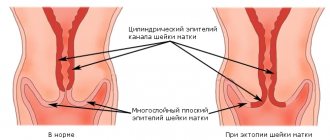Leukocytes (white immune blood cells) are the blood elements of the immune system. Their task is to ensure the body’s protection and fight against all kinds of harmful microorganisms, bacteria, microbes, and viruses.
They form in the bone marrow space and lymph nodes, but can move freely through the walls of blood vessels and move to places where there is potential danger. They exhibit antitoxic and antimicrobial effects.
Why there may be a lot of leukocytes in a gynecological smear in women - we will tell you the main reasons and treatment features below!
Symptoms and signs of increased white blood cells in the cervix
If a person experiences an increase or decrease in the number of leukocytes, then this condition will certainly affect the entire body. If there is a large number of leukocytes, a woman may feel the following symptoms in her genitourinary system:
- Difficulty in bowel movements and urination;
- Itching in the genital area;
- Vaginal discharge with an unpleasant odor;
- Feelings of pain in the anus and pelvis.
If there is an increased number of leukocytes in the body, then the woman notices problems with menstruation. A curd-like discharge is observed from the vagina in large quantities.
Most women with this kind of problem report that even with an active sex life they are unable to have a child. At the same time, in medicine one can find numerous cases in which the presence of a large number of leukocytes does not manifest itself in any way. In fact, this condition is quite dangerous, since there is no way to timely determine the presence of infectious diseases and inflammatory processes occurring in the cervix, as well as the internal organs located next to it.
If, when taking a smear from a woman’s cervix, a large number of leukocytes were detected, this may indicate the presence of a number of diseases, which include the following:
- Cancers of the urogenital organs;
- Fungal infections;
- Andexit;
- Urethritis;
- Colpitis;
- Venereal diseases;
- Dysbacteriosis.
In almost any disease of the genitourinary system, an increased number of leukocytes can be observed, in this case cervicitis will not be an exception.
If timely treatment is not started in the presence of the cervical canal, the disease will become chronic and can cause cervical erosion, dysplasia and the inability to have children. The main distinguishing feature of this disease is that it often does not manifest itself, but in some situations there are still certain symptoms of cervicitis. A woman may experience pain, burning and itching, and discomfort during sex in the genital area and abdomen. You need to understand that inflammation of the cervical canal can occur as a result of the following factors:
- Deformation of the cervix as a result of abortion;
- Low immune system;
- Irregular menstrual cycle;
- Stressful situations.
What else do you need to know about blood?
It should be noted that timely detection of pathologies in the body leads to their effective treatment. When the first symptoms (unpleasant sensations) appear, you must immediately consult a doctor who, through a personal examination and research, will be able to make a correct diagnosis and prescribe reasonable treatment.
Remember that oncology is not a death sentence. With proper therapy, you can stop the development of pathology, and identifying it in the early stages of the disease and timely treatment (in some cases) will help defeat this disease.
In antenatal clinics, the phenomenon of concealing important information about the health status of patients from themselves is often observed. Why doesn't the doctor explain how serious the problem is, what its causes are, how many treatment options there are? Why should a patient blindly believe in the recommendations of a gynecologist? If a specialist does not provide information, then it makes sense to figure out for yourself what and how it works, why failures occur in the system, and how to deal with them
One of the indicators of a woman’s health is the presence of white blood cells – leukocytes – in the bloodstream. They are responsible for the general immunity of the body, which makes it possible to accurately determine the presence of infectious agents. The activity of bacteria and viruses undermines the defenses by releasing the products of their vital activity. At the same time, reduced immunity suffers even more.
In gynecology, the number of leukocytes is determined by analyzing a smear from the cervical canal. If they are normal, then there is nothing to worry about. But it often happens that a woman does not feel any changes in her health, but her white blood cells increase.
Treatment, what to do, how to treat elevated white blood cells in the cervix?
Only after an examination and passing all the necessary tests can you find out exactly what caused such changes, and treatment should only be prescribed by a doctor.
In order for the procedure scheme to be drawn up correctly, a woman needs to undergo the following tests:
- Bacterial culture;
- Ultrasound examination of the pelvic organs;
- Urine and blood analysis.
Only a comprehensive analysis, which can be obtained during research, makes it possible to make an accurate diagnosis and determine the causes of the changes that have occurred. However, you should know that not in all cases the doctor prescribes antibacterial drugs. There are various diseases during which such treatment can only worsen the patient’s condition, for example, if she has thrush.
In this case, the condition will be alleviated not by antibacterial drugs, but by antifungal agents, as well as physiotherapeutic procedures, thanks to which the body’s resistance can be increased. If women have an increased level of leukocytes, then the following is used to treat them:
- Products with lacto- and bifidobacteria;
- Antibiotic drugs;
- Local antiseptics.
Sanitation procedures must be carried out in the vaginal area; they also affect the general condition of the cervix. The doctor should prescribe the woman to take a complex of vitamins, as well as restorative medications. It is also very important to protect your body during this period from possible toxins that occur while taking medications that reduce a high number of white blood cells. To cope with this situation, it is recommended to use hepaprotective agents.
Be that as it may, if during the examination it was possible to determine a large number of leukocytes - there are more than 15 units in the smear, then urgent measures must be taken.
In the presence of inflammatory processes in the genitourinary system, a woman may experience various complications, such as:
- Ovarian diffusion;
- Miscarriage;
- Hormonal imbalances.
If there are such problems, then this indicates a high level of leukocytes, the level of which can be confirmed by destructive changes and inflammation.
Treatment with drugs
The following methods are used to treat inflammatory diseases of the genital organs :
- Vaginal douching with antiseptic agents: miramistin, chlorhexidine, potassium permanganate;
- Antibacterial vaginal suppositories: “Genferon”, “Heksikon”, “Terzhinan”, “Viferon”;
- For candidiasis, the drugs Fluconazole and Flucostat are taken orally.
Treatment of infectious diseases requires intravenous administration of antibacterial drugs: Ornidazole, Tsiprinol, Metronidazole. Local vaginal douching with antiseptics is prescribed together. Upon completion of treatment, a course of restorative therapy is carried out, aimed at the vaginal population with beneficial bacteria, using eubiotics: “Bifidumbacterin”, “Lactobacterin”, Vagilak” and others.
Important: all medications should be taken strictly as prescribed by your doctor. Self-medication with antibiotics carries a lot of side effects.
What should be the reading of leukocytes in a smear?
To determine the condition of the reproductive organs and the reproductive system as a whole, in some cases you just need to take a smear. A large number of leukocytes is an alarming sign and an indicator of the existence of a pathological process in the body. If the patient’s health is in good condition, this is also reflected in the tests. Based on existing standards, it is necessary that the content of leukocytes in a smear be in this quantity:
- In the cervix - no more than 15, in rare cases 20;
- In the urethra - not exceeding 5;
- In the vagina - up to 10.
A number exceeding these indicators indicates a problem in the cervix or in some other organs. The more white blood cells are found in the smear, the more serious the disease and the sooner it is necessary to find the cause of its occurrence, as well as begin therapy. Advanced cases are more difficult to cure. They can be harbingers of serious complications.
Treatment with folk remedies
For inflammatory diseases, it is recommended to douche daily with the following decoctions :
- A tablespoon of chamomile, calendula, and stinging nettle flowers (optional) is poured into a glass of water, brought to a boil, removed from heat and left for half an hour. Before use, decoctions should be strained through a sieve or cheesecloth.
- Pour 6 cloves of chopped garlic into 1.5 liters of hot water, leave to steep overnight, and strain before use.
- Pour 2 cloves of chopped garlic into 2 cups of hot water, add 1.5 tablespoons of apple cider vinegar, stir and strain.
- For thrush: mix 1 dose of dry bifidumbacterin with a teaspoon of warm water, add 1 teaspoon of Vaseline. Soak a tampon with the resulting ointment and insert it into the vagina for 10 hours. Course of treatment: 7 – 10 days.
What diseases can cause an increase in leukocytes in the cervix
A change in discharge is considered one of the signals that the level of white blood cells has increased. The secretion from the mucous membranes of the genital organs becomes cheesy and has a not very pleasant smell. Also symptoms are: pain in the pelvic cavity, itching and burning in the genitals, failure of the frequency of menstruation. An increase in the content of leukocytes in the cervix may well mean the existence of disorders in the organs of the genitourinary system, such as inflammation of the cervical canal (cervicitis). If you do not begin to get rid of this problem in time, it will provoke erosion of the cervix, which in the future will cause infertility. During cervicitis, with a high level of white blood cells, the following symptoms are characteristic: frequent pain in the lower abdominal region; discomfort during sexual intercourse; itching in the genitourinary system.
Etiology of leukocytosis
Elevated white blood cells can be detected in the cervical canal due to failures of the reproductive sphere and failure of any other organ of the female body. High white blood cell counts are most often found when:
- Active inflammation of the cervical canal – cervicitis. The process may be limited to only a given area, or it may be widespread. Thus, the internal genital organs as a whole can be inflamed: tubes and ovaries, uterine lining, vagina.
- A clinical picture somewhat similar to inflammation can be observed by a doctor during a tumor process of the urinary tract and genital organs. Leukocyte infiltration often occurs here, as these cells seek to neutralize agents with an abnormal antigenic structure. In addition, the destruction of healthy tissue by a tumor also gives inflammatory symptoms, which form the causes of an increase in leukocytes in the cervical canal.
- Deviations from the norm of leukocytes directly in the cervical canal also occur in conditions such as intestinal or vaginal dysbiosis. An increased number of white blood cells forms an infiltrate that suppresses the action of opportunistic microorganisms.
- Hidden sexually transmitted infections, as well as sexually transmitted diseases with pronounced symptoms, directly mediate an increase in leukocytes in the cervix.
Various modifications of microorganisms currently make their detection a complex and time-consuming process. A smear from the cervix or other anatomical area is not always indicative. Elevated white blood cells are found in women outside the bacterial flora, which requires more accurate methods of recognizing microbes. In such cases, the improved polymerase chain reaction comes to the rescue, the complex mechanism of which makes it possible to detect in smears most of the pathogenic bacteria that cause inflammation of the cervix. These include mycoplasmas, gonococci, treponemas, trichomonas, amoebas, herpes virus, cytomegalovirus and many other microorganisms.
When there is no infection, but the level of leukocytes in the smear is increased, the reasons
Diseases of the genitourinary system in women occur with a variety of symptoms. Sometimes the white blood cell count is high, but there are no infections in the body. Even in such cases, it is necessary to contact a gynecologist for examination and laboratory tests. This should be done because the number of white blood cells cannot increase on its own and most likely means the existence of pathologies in the body. A slight increase in their content is usually a sign of discomfort in the vagina or lower segment of the uterus. If the excess is small, there is no cause for concern. This sometimes occurs in medical practice. However, if the white blood cell count is significantly higher than normal, treatment must be started without delay. Do not forget that very often a general blood test shows an excessively high content of leukocytes, but in a smear they, on the contrary, are in normal quantities. This means that a pathological process is occurring in the body and you should immediately consult a doctor.
Decoding the analysis results
Tests can detect bacteria and leukocytes in a smear. The norm in women (the table of normal indicators is given below) varies depending on the place where the analysis was taken, age and sexual activity.
When receiving test results to check the norm of leukocytes in a smear in women, it is important to familiarize yourself with the table of normal indicators. The following may be found in the discharge:
The following may be found in the discharge:
- Lactobacilli. Their presence in the vagina is normal. A small number of lactobacilli is a symptom of bacterial vaginosis;
- Gonococci. Normally absent, they cause gonorrhea;
- Cocchi. Can be gram-positive and gram-negative; gram-positive: staphylococcus, streptococcus and enterococcus should be present in the vagina, but their increased number indicates calpitis;
- Yeast. They are constantly present in the vagina in small quantities; the rate increases with the development of candidiasis;
- "Key" cells. They are formed as a result of the connection of squamous epithelial cells and gardnerella, their presence means the development of gardnerellosis or vaginosis;
- Leptothrix. The bacterium that causes candidiasis is normally absent;
- Trichomonas. Normally absent, causes chlamydia;
- Escherichia coli. The presence in a single number is acceptable; the accumulation of E. coli bacteria often indicates neglect of personal hygiene;
- Flat epithelium. Low values indicate atrophy of the epithelial layer, high values indicate the presence of inflammation.
Leukocytes in a smear in pregnant women
In women expecting a child, the level of leukocytes is measured several times. The first smear is done when registering for pregnancy. The number of white blood cells during pregnancy is from 15 to 20 units. When the number of leukocytes is not within standard limits, inflammatory reactions occur in the body of the expectant mother. This can become a threat to both the health of the woman and the child.
For correct diagnosis, various research methods are used, such as bacteriological, immunological, and polymerase chain reaction analysis. The occurrence of any disease is not evidence of early infection. Hormonal changes and deterioration of the body's immunity, which occur during pregnancy, can cause the development of a latent infection.
Typically, inflammation in the genitourinary organs means the presence of infectious or sexually transmitted diseases. Moreover, in addition to the listed stimulators of an increase in leukocytes in a smear, the cause of an increase in their number is also a fungal disease - candidiasis. The weakening of the protective functions in the body causes the appearance of fungal infections, which mainly occur in pregnant women in the later stages.
Source: womanchoise.ru
Similar articles
- Pathology of the endometrium of the uterus, causes, types and treatment Recently, many women have encountered diseases of the uterine mucosa. Pathologies of the endometrium of the uterus are observed in representatives of the fairer sex, regardless of their age, and they can lead to very negative consequences. Often…
- Fluid in the uterine tube (hydrosalpinsk), causes and treatment As a result of the fact that the fallopian tube is greatly narrowed, fluid may begin to accumulate, an adhesive process begins, as a result of which a certain bag appears in which all the fluid collects. If we talk about the varieties of this disease,...
- Cervical erosion: treatment, symptoms, causes The term “erosion” is widely used in practical life and literature for the pathological process on the vaginal part of the cervix, characterized in the initial stage by dystrophy and desquamation of squamous multilayer epithelium (ulceration, erosion) with subsequent development on ...
Less common causes
White blood cells in the cervical canal differ from the normal value for some other less common reasons. Thus, dysbiosis of the genital organs described above may be a consequence of general somatic and autoimmune pathologies:
- Leukocyte infiltration of the cervical canal or cervicitis occurs during hormonal imbalances in girls during puberty, as well as during the decline of reproductive reproduction or menopause. Endocrine imbalance mediates pregnancy, as well as its spontaneous or forced termination. Increased or decreased production of hormones by some organs becomes an impetus for an increase in leukocytes in the cervical canal against the background of activation of the opportunistic microflora of the endocervix.
- Elevated white blood cells are found in women in a smear from the cervix after a sharp drop in general immunity. The reason for this may be hypothermia, taking broad-spectrum antibiotics.
- Exposure to chronic stress causes significant damage to a woman's health. It can also be reflected by leukocyte infiltration of the endocervix, a general imbalance of the vaginal microflora. Overwork and heavy physical labor may also be accompanied by this symptom.
- Elevated leukocytes in smears from the cervix can also occur after intense sexual intercourse. Hard copulation causes microtrauma and cracks in the vagina, to which white blood cells quickly react.
- If a woman often changes sexual partners, this can also affect the cellular composition in the cervical canal. A large number of leukocytes neutralizes the constant change of bacterial flora.
- Leukocyte infiltration in the endocervix can be a side effect of chemotherapy or radiation treatment.
- Excessive enthusiasm for hygiene rules, as well as their complete absence, harms the microflora of the genital organs. The use of douching changes the cellular composition of the internal environment, sometimes not for the better, causing inflammation and migration of leukocytes. Neglect of basic hygiene procedures causes the proliferation of opportunistic microorganisms, which white blood cells also seek to neutralize.
- Some barrier concentration agents cause leukocytosis in the cervix. Various spermicides in the pharmacological forms of suppositories or ointments disrupt the existing balance of the sexual environment. Inflammation and leukocytosis in the genitals also occur as allergic reactions to male sperm.
- The anatomical structure of the genital organs can be changed by congenital deformities, during pathological childbirth, or surgical interventions. This leads to shifts in the cellular environment in the cervical canal and adjacent areas, where white blood cells tend to increase.
- Foreign bodies also lead to cellular-bacterial imbalance of the genital organs. The norm of leukocytes in the cervical canal is never observed in women who use hygienic tampons.
- Temperature changes, prolonged hypothermia or overheating of the female body harm the cellular composition of the endocervix. An imbalance is also caused by tight underwear, panties made of synthetic fabric and thongs.
Erosion
There is also such a thing as pseudo-erosion
It is important to understand that erosion is an unhealed area, and pseudo-erosion is a healed area, but not healed very carefully, which is why, like erosion, it is easy to visualize
The difference is that erosion is a modification of tissue with signs of damage, a wound, and pseudo-erosion is also damaged tissue, but without signs of damage. Sometimes it transforms into a malignant neoplasm.
If a woman with elevated leukocytes in the smear, all other tests are good, there are no ailments or pathological conditions, but erosion is present, then this is the cause of leukocytosis. However, in this case, no treatment is required, and the erosion must be observed (if it does not grow).











